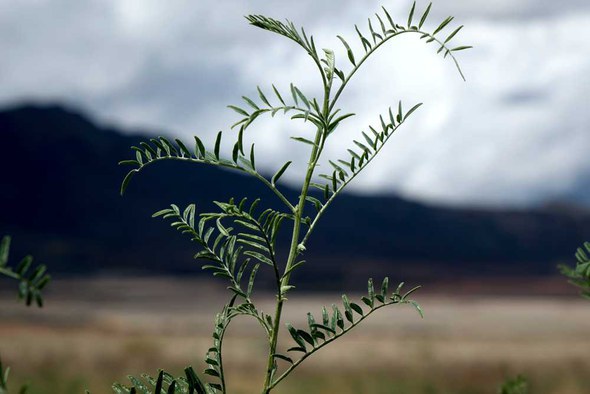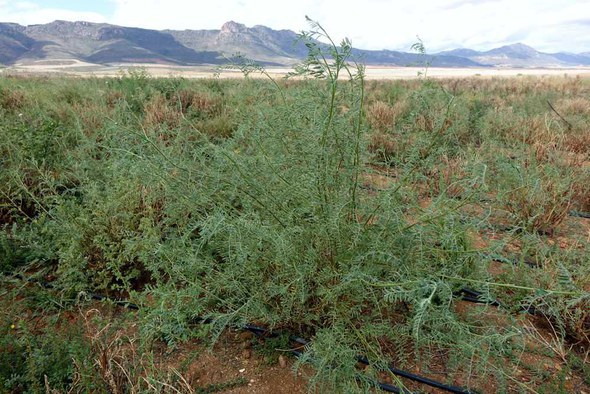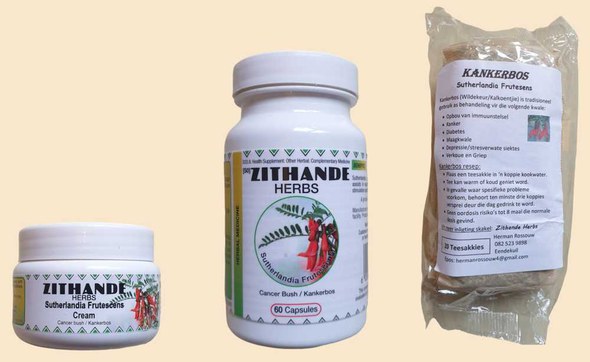CANCER BUSH (Sutherlandia frutescens) – Kankerbos (Afrikaans)

Traditional Uses of Cancerbush
Traditionally, no distinction is made between the use of S. frutescens and the closely related S. microphylla for medicinal purposes, and these plants are among the most versatile and useful medicinal plants in southern Africa.
Tinctures, infusions and decoctions of the leaves and young stems of the two species were used in the Cape from early times, the uses originally learned from the Khoi and San.

Botanical characteristics of cancerbush
Cancerbush belongs to the plant family Fabaceae, whose scientific name stands for the legume or Leguminosae family.
The Cancer Bush is an attractive shrub about one meter tall with silvery leaves, red flowers and balloon-like pods.
Cancerbush belongs to the fynbos plant family, which also includes rooibos, buchu and honeybush, which is found exclusively in the Cape Province.

The Health Benefits of Cancerbush's Bitter Taste
Cancerbush's bitter taste is due to various chemical compounds, including saponins, flavonoids, and bitter compounds such as amarogentin, a specific compound known for its bitterness.
These bitter substances serve as a protective mechanism for the plant against herbivores and can also help protect the plant from pathogenic organisms, that is, from microorganisms such as bacteria, viruses or fungi that can cause disease.
In addition, bitter substances can also play a role in stimulating the digestive system by increasing the production of digestive juices and enzymes.

Discover your own aroma composition
If the pure infusion of Cancerbush tea is too bitter for you, you have the option to temper it to your taste. You can mix it with rooibos, buchu or honeybush, depending on the level of bitterness you prefer, and for an extra touch of flavor you can add slices of fresh ginger.
Let yourself be seduced by the fascinating variety of aromas of your own tea blend. Starting with a refreshing citrus mint from Buchu, the natural sweetness of Honeybush follows, before the slight bitterness of Cancerbush unfolds in the finish, accompanied by the gentle spiciness of fresh ginger.

Health Benefits and Medical Uses
Sutherlandia species are considered the ultimate adaptogens from Africa, which are natural substances that can help the body adapt to stressful situations and increase physical and mental performance. The plants of the Sutherlandia genus are considered particularly effective adaptogens and offer a variety of health benefits when consumed regularly.
Conditions that have been treated with these plants include fever, loss of appetite, indigestion, gastritis, esophagitis, stomach ulcers, dysentery, cancer (prevention and treatment), diabetes, colds and flu, cough, asthma, chronic bronchitis, kidney and liver diseases , rheumatism, heart failure, urinary tract infections, cystitis and stress and anxiety.
The plant has been used as a douche for uterine prolapse and after delivery, a decoction is taken on the same day to expel blood residue, treat pain after childbirth and support the healing and dissolution of the uterus.
Sutherlandia microphylla has been used to treat amenorrhea (Watt & Breyer-Brandwijk 1962).
Sutherlandia preparations are taken chronically as needed but should not be taken during pregnancy as teratogenicity and abortion have been known to occur (Dawid & Mrs Bester, personal communication).
There are a few strongly supported recent anecdotes that Cancer Bush appeared to be of significant benefit in the treatment of pancreatic and other cancers and improved the quality of life of patients with late-stage breast cancer and pain and inflammation associated with rheumatoid arthritis.

Scientific knowledge and potential
A number of highly active compounds, including canavanine, pinitol and the amino acid GABA, are found in large quantities in Sutherlandia species, suggesting that there is indeed a scientific basis for some of the folk uses for serious medical illnesses.
L-Canavanine is a potent L-arginine antagonist that has been shown to have anticancer (Swaffar et al. 1995, Crooks & Rosenthal 1994) and antiviral effects, including use against influenza virus and retroviruses (Green 1988).
Canavanine is an inhibitor of nitric oxide synthase and may be helpful in certain forms of heart failure (Liaudet et al. 1996). Pinitol is a well-known antidiabetic drug (Narayanan et al. 1987) that may also have use in the treatment of muscle wasting in cancer and AIDS (Ostlund & Sherman 1996).
GABA is an inhibitory neurotransmitter that may be responsible for the use of S. frutescens and S. microphylla in anxiety and stress.
The seeds and leaves of S. frutescens were smoked as a dagga substitute in Namaqualand by workers and teenagers, and some farmers subsequently removed them from their land (Fiona Archer, Lita Cole & Dawid Bester, personal communication).
The leaves of S. microphylla have a sedative effect when smoked, and high concentrations of GABA have been found in several samples from different species and subspecies.

Ongoing research and commercial products
In the plantations of S. frutescens and S. microphylla, continuous work is being done to select suitable chemotypes. The first commercial products have already been developed, while work continues to improve and further develop the chemotypes.
Farmer Herman Rossouw from Meerlandsvlei Boerdery processes cancerbush in various ways. He makes tea from it, both pure and in combination with honeybush and rooibos. In addition, capsules and skin care creams with Cancerbush are offered.




